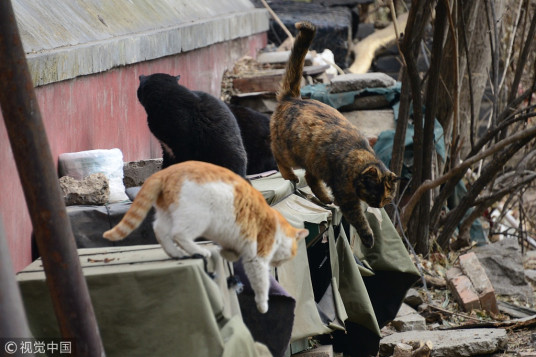Purrfect! A smart shelter powered by AI keeps stray cats warm in winter
 |
|
Three stray cats wander at the Wofo Temple in Beijing, Feb 26, 2018. [Photo/VCG] |
A constant temperature of 27 degrees, a water bowl that never freezes, a comfy mat, and no dogs allowed.
Those are the amenities for felines in a neighborhood in Beijing's Shunyi district, where stray cats can loll around contentedly all winter, nibbling food and sipping water, safe from the weather and provided with love through an artificial intelligence platform. It is purrfection.
Wan Xi, an engineer at Baidu Brain-the open AI platform of Baidu-had the idea of building a smart shelter for strays when he found a kitten huddled on his car tire in the winter of 2017.
Winter is rough for stray animals, as they require extra calories to stay warm. Only around 40 percent of stray cats find enough food and shelter to make it through the harsh temperatures.
Although volunteers offer water, food and even heating pads to stray animals, Beijing's freezing winters can turn a bowl of water into ice before a cat can drink. Many stray cats don't live more than two years. Those that are not neutered or spayed face more health problems and spawn more homeless cats.
Chinese netizens have dubbed Wan Xi-he doesn't give his real name-"the most hardcore cat lover" for building the AI cat shelter.
The wooden box, 165 centimeters tall, is cozy with a small entry. Inside is a multilevel cat den with a scratching post, plush resting places, dangling toys and hideaways.
The access control system features AI facial recognition technology. A high-definition camera on top can identify 174 kinds of cats and let them enter or exit as they wish. It has night vision to let in any ginger toms or gray tabbies wandering by at night.
The camera can check cats for four common feline diseases, including inflammation of the mouth and gums, skin problems and trauma. It can identify a neutered cat by spotting its ear tag within 300 milliseconds.
Once a sick or non-neutered cat is identified, volunteers get an alert on their cellphones and come to help.
Wan said the facial recognition system was developed on Baidu's EasyDL platform, a no-code tool that helps users build customized machine learning models. The system was "trained" with thousands of images of cat faces.
The temperature inside the smart cattery is maintained at 27 degrees, at which cats feel most comfortable and relaxed.
It also has a ventilation system that monitors the air inside in real time.
Wan said stray cats in the neighborhood are more nervous at first and just wander around curiously. After one brave mongrel made the first visit, others followed.
Stray cats are often emotionally sensitive, so the door will not close the minute a cat enters. The animal will have time to get used to the cattery without being jittery. Seven or eight cats come to rest in the shelter every day.
Wan hopes more smart shelters will be set up in the neighborhood.
The development of artificial intelligence is helping Beijing's dogs, too. At the suggestion of the local government, AI startup Megvii developed a dog facial recognition system to help reunite owners with lost pets.
Just as humans can be identified by their unique fingerprints, dogs can be identified by their distinctive noses.
Xie Yinan, vice-president of Megvii, said the company has built a dog nose-print database with 1 million images to train the machine-learning model, and the system is expected to help improve the stray dog problem in the city.
It is estimated that the population of stray animals in Beijing surpassed 1 million back in 2005. Homeless animals lead to public health problems, but poisoning and shooting them has sparked debate about humane animal control methods.
Everyone has their own way to communicate with the world, said Wan. "I believe that technology can make the world a warmer and better place."
